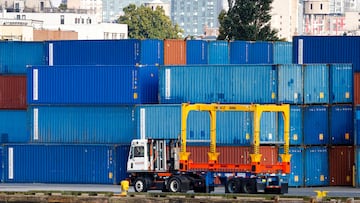The groceries most likely to experience shortages during a port strike
As a major strike of 45,000 port workers looms, we look at the groceries that could see shortages.


Starting Tuesday, October 1, a strike of 45,000 port workers affecting ports along the Gulf and East Coast could begin. The strike could cost $4.5 billion a day and would come with severe economic repercussions as forty percent of the products imported and exported from the US would be affected. Understanding the importance of their labor to national and international supply chains, members of the International Longshoremen’s Association (ILA) are taking a stand against what they see as decades of deteriorating labor conditions. The ILA accuses the companies represented by the United States Maritime Alliance (USMX) in negotiations of stalling and waiting until the last possible moment to reach an agreement. In sectors like transport and shipping, federal law gives powers to the president to break a strike that threatens national security. In 2022, the controversial Taft-Hartely Act was used to inhibit rail workers from striking, and instead, the federal government imposed an agreement between workers and their bosses.
The Biden administration has shown an unwillingness to intervene this time around but still has the power to do so if an agreement is not reached by midnight. The AFL-CIO, which the ILA is a member of, has advised the federal government to avoid intervening as such actions undercut workers’ power, giving companies an easy excuse not to bargain in good faith.
The ILA's fight for a fair contract is the entire labor movement’s fight. By even suggesting a possible injunction, @HouseGOP members make a deal less likely and a strike more likely. We’re urging them to call on USMX to make a fair offer and settle the contract before October 1. pic.twitter.com/E9v9fU8Rnn
— AFL-CIO ✊ (@AFLCIO) September 26, 2024
If the strike begins, consumers could start to feel the pinch as increased costs are passed along by companies seeing their products held up in the ports. And while understandably frustrating, one should be careful not to fall victim to corporate propaganda that pits workers against one another. Port workers are a critical component of the integrity of US supply chains. During the pandemic, they, along with grocery store workers, meat packers, and agriculture laborers, showed up and ensured shelves were stocked. Now, as profits have exploded for transportation and shipping companies, ILA members are demanding they share in the profits their labor generates. Already, one can see examples in the media where union members are being blamed for an impending supply chain crisis when they are only one party in the negotiation and, under current law, have far less power than the bosses sitting opposite them.
Since the USMX announced that they would be filing a brief with the National Labor Relations Board on Thursday, September 26, only the ILA has released a statement. The brief was an attempt to force the ILA negotiations back to the table, but little is known about how much the parties have spoken since. The ILA leadership remained steadfast in stating that a strike was imminent. “United States Maritime Alliance (USMX) refuses to address a half-century of wage subjugation where Ocean Carriers profits skyrocketed from millions to mega-billion dollars, while ILA longshore wages remained flat,” posted the organization on their Facebook page. The union also said they would publish another update for their members and the media by 11 am ET on Monday, September 30.
READ MORE: How would a port strike along the East Coast affect the US economy?
What food does the US import the most of?
Related stories
According to the US Department of Agriculture, the US food system is most reliant on imports when it comes to sweeteners, and processed sugar, and confections. Though sugars are products that households buy at the grocery store, companies and businesses are also major consumers, which could push up prices across goods that contain these ingredients.
In addition, depending on the season, fruits, vegetables, and nuts are also imported at higher rates than other food products. Again, a shortage of fruits and vegetables could lead prices to rise beyond the produce section of your local supermarket. For instance, restaurants would also be impacted, and this could lead them to increase prices, which will be felt as inflation. Perishable goods have an additional risk because they cannot be sold later, even if they are held up in the ports for a few days. Silo, a food supply chain software company, reported that avocados, bananas, and grapes are the most common types of produce imported to the US, representing around forty-one percent of all fruit and vegetable imports.
Complete your personal details to comment